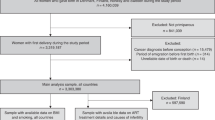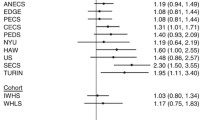Abstract
Although full-term pregnancies reduce the risk of ovarian cancer, it has not been conclusively established whether incomplete pregnancies also influence risk. We investigated the relationship between a history of incomplete pregnancy and incident epithelial ovarian cancer among over 4,500 women who participated in two large Australian population-based case–control studies in 1990–1993 and 2002–2005. They provided responses to detailed questions about their reproductive histories and other personal factors. Summary odds ratios (OR) and confidence intervals (CI) derived for each study using the same covariates were aggregated. We found no significant associations between the number of incomplete pregnancies and ovarian cancer, for parous (OR = 0.98, 95% CI: 0.89, 1.08) or nulliparous (OR = 1.06, 95% CI: 0.75, 1.48) women, nor for the number of spontaneous or induced abortions and ovarian cancer for parous women (OR = 0.95, 95% CI 0.82, 1.09; OR = 1.08, 95% CI: 0.86, 1.36) or nulliparous women (OR = 1.2, 95% CI: 0.6, 2.4; OR = 0.8, 95% CI: 0.47, 1.38), respectively. A systematic review of 37 previous studies of the topic confirmed our findings that a history of incomplete pregnancy does not influence a woman’s risk of epithelial ovarian cancer.
Similar content being viewed by others
References
Jemal A, Murray T, Ward E, Samuels A, Tiwari RC, Ghafoor A et al (2005) Cancer statistics, 2005. CA Cancer J Clin 55(1):10–30
Cancer Research UK (2005) Cancer stats mortality–UK. London: Cancer research UK 2005 September 2005
Australian Institute of Health and Welfare (AIHW) & Australasian Association of Cancer Registries (AACR). Cancer in Australia (1999) Canberra: AIHW2002. Report No.: AIHW cat. no. CAN 15. Cancer Series no. 20
Whittemore AS, Harris R, Itnyre J (1992) Collaborative ovarian cancer group. Characteristics relating to ovarian cancer risk: collaborative analysis of 12 US case–control studies. II. Invasive epithelial ovarian cancers in white women. Am J Epidemiol 136(10):1184–1203
Fathalla MF (1971) Incessant ovulation: a factor in ovarian neoplasia? [letter]. Lancet 2:163
Stadel BV (1975) The aetiology and prevention of ovarian cancer. Am J Obstet Gynaecol 123:772–774
Purdie D, Green A, Bain C, Siskind V, Ward B, Hacker N et al (1995) Reproductive and other factors and risk of epithelial ovarian cancer: an Australian case-control study. Survey of women’s health study group. Int J Cancer 62(6):678–684
Australian Electoral Commission (1999) Australian electoral commission annual report 1998–1999. Australian Electoral Commission, Canberra
Olsen CM, Bain CJ, Jordan SJ, Nagle CM, Green AC, Whiteman DC et al (2007) Recreational physical activity and epithelial ovarian cancer: a case–control study, systematic review, and meta-analysis. Cancer Epidemiol Biomarkers Prev 16(11):2321–2330
Kvale G, Heuch I, Nilssen S, Beral V (1988) Reproductive factors and risk of ovarian cancer: a prospective study. Int J Cancer 42(2):246–251
Rosenblatt KA, Gao DL, Ray RM, Rowland MR, Nelson ZC, Wernli KJ et al (2006) Induced abortions and the risk of all cancers combined and site-specific cancers in Shanghai. Cancer Causes Control 17(10):1275–1280
Casagrande JT, Louie EW, Pike MC, Roy S, Ross RK, Henderson BE (1979) “Incessant ovulation” and ovarian cancer. Lancet 2(8135):170–173
Chen MT, Cook LS, Daling JR, Weiss NS (1996) Incomplete pregnancies and risk of ovarian cancer (Washington, United States). Cancer Causes Control 7(4):415–420
Chen Y, Wu PC, Lang JH, Ge WJ, Hartge P, Brinton LA (1992) Risk factors for epithelial ovarian cancer in Beijing, China. Int J Epidemiol 21(1):23–29
Cramer DW, Hutchison GB, Welch WR, Scully RE, Ryan KJ (1983) Determinants of ovarian cancer risk. I. Reproductive experiences and family history. J Natl Cancer Inst 71(4):711–716
Gierach GL, Modugno F, Ness RB (2005) Relations of gestational length and timing and type of incomplete pregnancy to ovarian cancer risk. Am J Epidemiol 161(5):452–461
Harlow BL, Weiss NS, Roth GJ, Chu J, Daling JR (1988) Case–control study of borderline ovarian tumors: reproductive history and exposure to exogenous female hormones. Cancer Res 48(20):5849–5852
Nasca PC, Greenwald P, Chorost S, Richart R, Caputo T (1984) An epidemiologic case–control study of ovarian cancer and reproductive factors. Am J Epidemiol 119(5):705–713
Riman T, Dickman PW, Nilsson S, Correia N, Nordlinder H, Magnusson CM et al (2002) Risk factors for invasive epithelial ovarian cancer: results from a Swedish case–control study. Am J Epidemiol 156(4):363–373
Risch HA, Marrett LD, Howe FR (1994) Parity, contraception, infertility and the risk of epithelial ovarian cancer. Am J Epidemiol 140(7):585–597
Shu XO, Brinton LA, Gao YT, Yuan JM (1989) Population-based case–control study of ovarian cancer in Shanghai. Cancer Res 49(13):3670–3674
The Cancer and Steroid Hormone Study of the Centers for Disease Control and the National Institute of Child Health and Human Development (1987) The reduction in risk of ovarian cancer associated with oral-contraceptive use. N Engl J Med 316(11): 650–655
Titus-Ernstoff L, Perez K, Cramer DW, Harlow BL, Baron JA, Greenberg ER (2001) Menstrual and reproductive factors in relation to ovarian cancer risk. Br J Cancer 84(5):714–721
Weiss NS, Lyon JL, Liff JM, Vollmer WM, Daling JR (1981) Incidence of ovarian cancer in relation to the use of oral contraceptives. Int J Cancer 28(6):669–671
Whittemore AS, Wu ML, Paffenbarger RS Jr, Sarles DL, Kampert JB, Grosser S et al (1988) Personal and environmental characteristics related to epithelial ovarian cancer. II. Exposures to talcum powder, tobacco, alcohol, and coffee. Am J Epidemiol 128(6):1228–1240
Bernal A, Mendez-Moran L, Fajardo-Gutierrez A, Gonzalez-Lira G, Escudero P, Ortiz H (1995) Univariate and multivariate analysis of risk factors for ovarian cancer: case–control study, Mexico City. Arch Med Res 26(3):245–249
Booth M, Beral V, Smith P (1989) Risk factors in ovarian cancer: a case–control study. Br J Cancer 60:592–598
Byers T, Marshall J, Graham S, Mettlin C, Swanson M (1983) A case–control study of dietary and nondietary factors in ovarian cancer. J Natl Cancer Inst 71(4):681–686
Chiaffarino F, Pelucchi C, Parazzini F, Negri E, Franceschi S, Talamini R et al (2001) Reproductive and hormonal factors and ovarian cancer. Ann Oncol 12(3):337–341
El-Khwsky FS, Maghraby HK, Rostom YA, Abd El-Rahman AH (2006) Multivariate analysis of reproductive risk factors for ovarian cancer in Alexandria, Egypt. J Egypt Natl Canc Inst 18(1):30–34
Greggi S, Parazzini F, Paratore MP, Chatenoud L, Legge F, Mancuso S et al (2000) Risk factors for ovarian cancer in central Italy. Gynecol Oncol 79(1):50–54
Hartge P, Schiffman MH, Hoover R, McGowan L, Lesher L, Norris HJ (1989) A case–control study of epithelial ovarian cancer. Am J Obstet Gynecol 161(1):10–16
Hildreth NG, Kelsey JL, LiVolsi VA, Fischer DB, Holford TR, Mostow ED et al (1981) An epidemiologic study of epithelial carcinoma of the ovary. Am J Epidemiol 114(3):398–405
Joly DJ, Lilienfeld AM, Diamond EL, Bross ID (1974) An epidemiologic study of the relationship of reproductive experience to cancer of the ovary. Am J Epidemiol 99(3):190–209
McGowan L, Parent L, Lednar W, Norris HJ (1979) The woman at risk for developing ovarian cancer. Gynecol Oncol 7(3):325–344
Mori M, Harabuchi I, Miyake H, Casagrande JT, Henderson BE, Ross RK (1988) Reproductive, genetic, and dietary risk factors for ovarian cancer. Am J Epidemiol 128(4):771–777
Parazzini F, La Vecchia C, Negri E, Gentile A (1989) Menstrual factors and the rise of epithelial ovarian cancer. J Clin Epidemiol 42(5):443–448
Polychronopoulou A, Tzonou A, Hsieh CC, Kaprinis G, Rebelakos A, Toupadaki N et al (1993) Reproductive variables, tobacco, ethanol, coffee and somatometry as risk factors for ovarian cancer. Int J Cancer 55(3):402–407
Salazar-Martinez E, Lazcano-Ponce EC, Gonzalez Lira-Lira G, Escudero-De los Rios P, Salmeron-Castro J, Hernandez-Avila M (1999) Reproductive factors of ovarian and endometrial cancer risk in a high fertility population in Mexico. Cancer Res 59(15):3658–3662
Tzonou A, Day NE, Trichopoulos D, Walker A, Saliaraki M, Papapostolou M et al (1984) The epidemiology of ovarian cancer in Greece: a case–control study. Eur J Cancer Clin Oncol 20(8):1045–1052
West RO (1966) Epidemiologic study of malignancies of the ovaries. Cancer 19(7):1001–1007
Wu ML, Whittemore AS, Paffenbarger RS Jr, Sarles DL, Kampert JB, Grosser S et al (1988) Personal and environmental characteristics related to epithelial ovarian cancer. I. Reproductive and menstrual events and oral contraceptive use. Am J Epidemiol 128(6):1216–1227
Wynder EL, Dodo H, Barber HR (1969) Epidemiology of cancer of the ovary. Cancer 23(2):352–370
Yen ML, Yen BL, Bai CH, Lin RS (2003) Risk factors for ovarian cancer in Taiwan: a case–control study in a low-incidence population. Gynecol Oncol 89(2):318–324
Zhang M, Lee AH, Binns CW (2004) Reproductive and dietary risk factors for epithelial ovarian cancer in China. Gynecol Oncol 92(1):320–326
Newhouse ML, Pearson RM, Fullerton JM, Boesen EA, Shannon HS (1977) A case control study of carcinoma of the ovary. Br J Prev Soc Med 31(3):148–153
Rosenberg L, Shapiro S, Slone D, Kaufman DW, Helmrich SP, Miettinen OS et al (1982) Epithelial ovarian cancer and combination oral contraceptives. JAMA 247(23):3210–3212
Negri E, Franceschi S, Tzonou A, Booth M, La Vecchia C, Parazzini F et al (1991) Pooled analysis of 3 European case–control studies: I. Reproductive factors and risk of epithelial ovarian cancer. Int J Cancer 49(1):50–56
Riman T, Dickman PW, Nilsson S, Correia N, Nordlinder H, Magnusson CM et al (2001) Risk factors for epithelial borderline ovarian tumors: results of a Swedish case–control study. Gynecol Oncol 83(3):575–585
Bean JA, Leeper JD, Wallace RB, Sherman BM, Jagger H (1979) Variations in the reporting of menstrual histories. Am J Epidemiol 109(2):181–185
Zielhuis GA, Hulscher ME, Florack EI (1992) Validity and reliability of a questionnaire on fecundability. Int J Epidemiol 21(6):1151–1156
Jobe JB, Mingay DJ (1989) Cognitive research improves questionnaires. Am J Public Health 79:1053–1055
Armstrong BK, White E, Saracci R (1992) Principles of exposure measurement in epidemiology. 1st ed. Kelsey Jl, Marmot MG, Stolley PD, Vessey MP, editors. Oxford: Oxford University Press
Fu H, Darroch JE, Henshaw SK, Kolb E (1998) Measuring the extent of abortion underreporting in the 1995 National Survey of Family Growth. Fam Plann Perspect 30(3):128–33, 38
Udry JR, Gaughan M, Schwingl PJ, van den Berg BJ (1996) A medical record linkage analysis of abortion underreporting. Fam Plann Perspect 28(5):228–231
Anderson BA, Katus K, Puur A, Silver BD (1994) The validity of survey responses on abortion: evidence from Estonia. Demography 31(1):115–132
Tang MT, Weiss NS, Daling JR, Malone KE (2000) Case–control differences in the reliability of reporting a history of induced abortion. Am J Epidemiol 151(12):1139–1143
Lindefors-Harris BM, Eklund G, Adami HO, Meirik O (1991) Response bias in a case–control study: analysis utilizing comparative data concerning legal abortions from two independent Swedish studies. Am J Epidemiol 134(9):1003–1008
Acknowledgments
Funding for Case Control Study 1 was provided by the Australian National Health and Medical Research Council and the Queensland Cancer Fund, and for Case Control Study 2 by the U.S Army Medical Research and Materiel Command, the National Health and Medical Research Council of Australia, the Cancer Council Tasmania and the Cancer Foundation of Western Australia.
We gratefully acknowledge the cooperation of the following institutions: New South Wales: John Hunter Hospital, North Shore Private Hospital, Royal Hospital for Women, Royal North Shore Hospital, Royal Prince Alfred Hospital, Westmead Hospital, New South Wales Cancer Registry; Queensland: Mater Misericordiae Hospital, Royal Brisbane and Women’s Hospital, Townsville Hospital, Wesley Hospital, Queensland Cancer Registry; South Australia: Flinders Medical Centre, Queen Elizabeth II, Royal Adelaide Hospital, South Australian Cancer Registry; Tasmania: Royal Hobart Hospital; Victoria: Freemasons Hospital, Mercy Hospital For Women, Monash Medical Centre, Royal Women’s Hospital, Victorian Cancer Registry; Western Australia: King Edward Memorial Hospital, St John of God Hospitals Subiaco, Sir Charles Gairdner Hospital, Western Australia Research Tissue Network (WARTN), Western Australia Cancer Registry. We also acknowledge the contribution of the study nurses and research assistants and would like to thank all of the women who participated in the study.
Author information
Authors and Affiliations
Consortia
Corresponding author
Additional information
Full membership of the Australian Ovarian Cancer Study Group is listed at http://www.aocstudy.org/; the Australian Cancer Study Investigators are A. Green, P. Parsons, N. Hayward, P. Webb, and D. Whiteman.
Rights and permissions
About this article
Cite this article
Dick, ML.B., Siskind, V., Purdie, D.M. et al. Incomplete pregnancy and risk of ovarian cancer: results from two Australian case–control studies and systematic review. Cancer Causes Control 20, 1571–1585 (2009). https://doi.org/10.1007/s10552-009-9402-3
Received:
Accepted:
Published:
Issue Date:
DOI: https://doi.org/10.1007/s10552-009-9402-3




